The Ultimate Guide to Cycling Tuscany
The only guide you need for cycling Tuscany: top routes, best seasons, base towns, must-see places, transport tips, and expert advice for an unforgettable ride.

Quick Links
Thinking about cycling Tuscany? You’re in for one of the best riding experiences in Europe. Few places mix smooth roads, rolling hills, historic towns, and legendary food the way Tuscany does — and that’s before you even touch the famous Strade Bianche gravel.
This guide keeps things practical, fun, and easy to use — perfect whether you’re planning your first trip or coming back for more.
What you’ll find in this guide

Why Cycle Tuscany
Tuscany is one of Italy’s most rewarding regions for cyclists, offering a rare combination of beautiful terrain, rich culture, and strong cycling infrastructure.
Here are the key reasons riders from all over the world choose Tuscany for their cycling holidays:
1. Varied terrain for all levels
Tuscany offers everything from gentle vineyard hills and scenic valleys to challenging climbs in the Apennines and fast, flat rides near Lucca and the coast. You can easily mix different riding styles in one trip.
Not sure how to combine all these in one trip? Ask our experts!
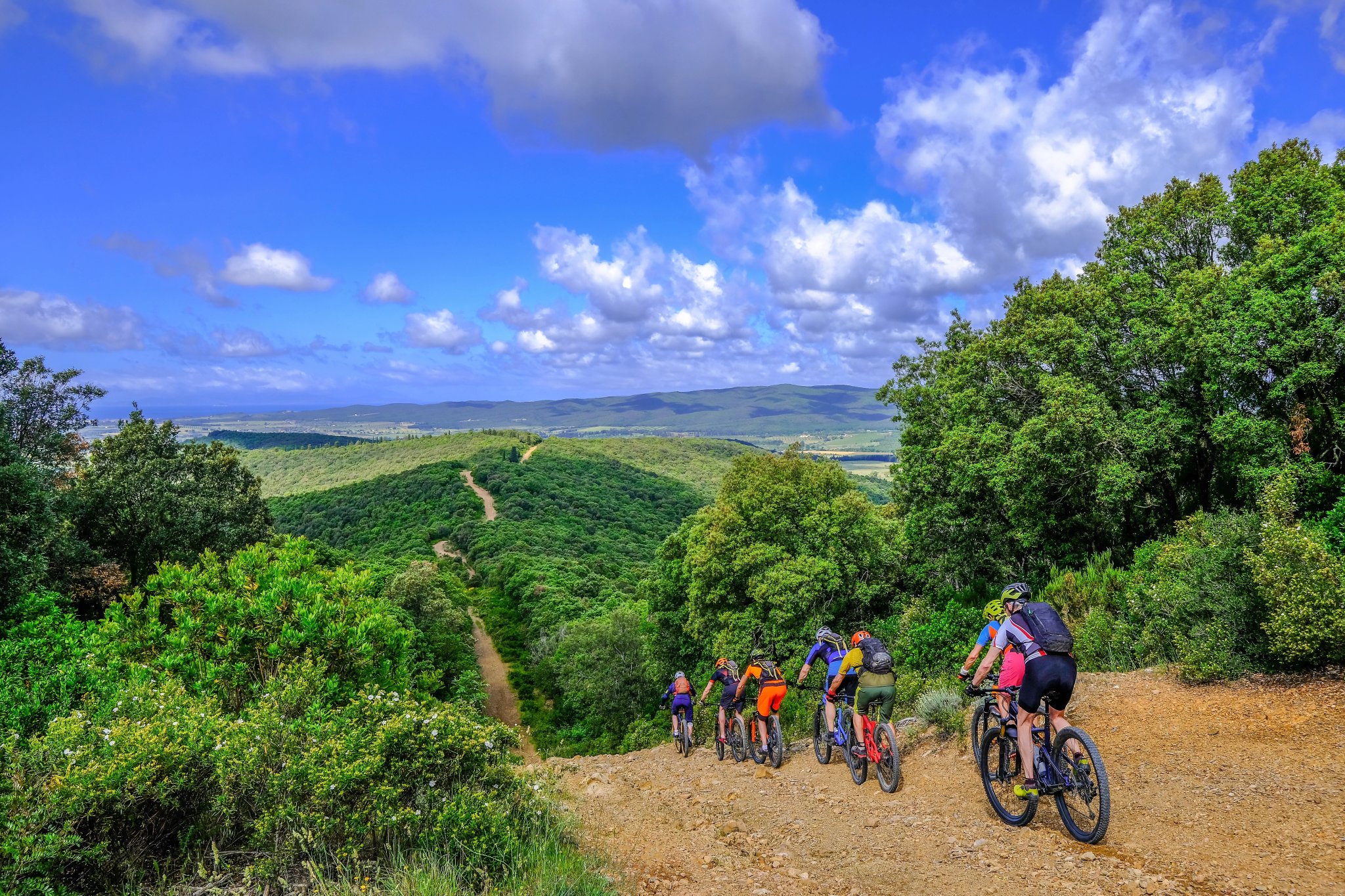
2. Iconic white gravel roads (Strade Bianche)
Tuscany is home to the famous “strade bianche” — white gravel roads made legendary by the Strade Bianche professional race. These quiet rural roads provide some of the most atmospheric gravel riding in Europe.

3. A rich cultural and historical backdrop
Cycling here means riding through medieval towns, UNESCO landscapes, fortified villages, monasteries, and postcard-perfect hilltops. Every route comes with built-in sightseeing.

4. Food, wine, and local flavour along the way
Tuscany blends cycling with gourmet culture: Chianti Classico tastings, pecorino from Pienza, handmade pasta, olive oil mills, and farm-to-table trattorias. Refuelling becomes part of the experience.
If you’d like to combine the culinary experience with cycling, check out our Wine & Bike Tour.
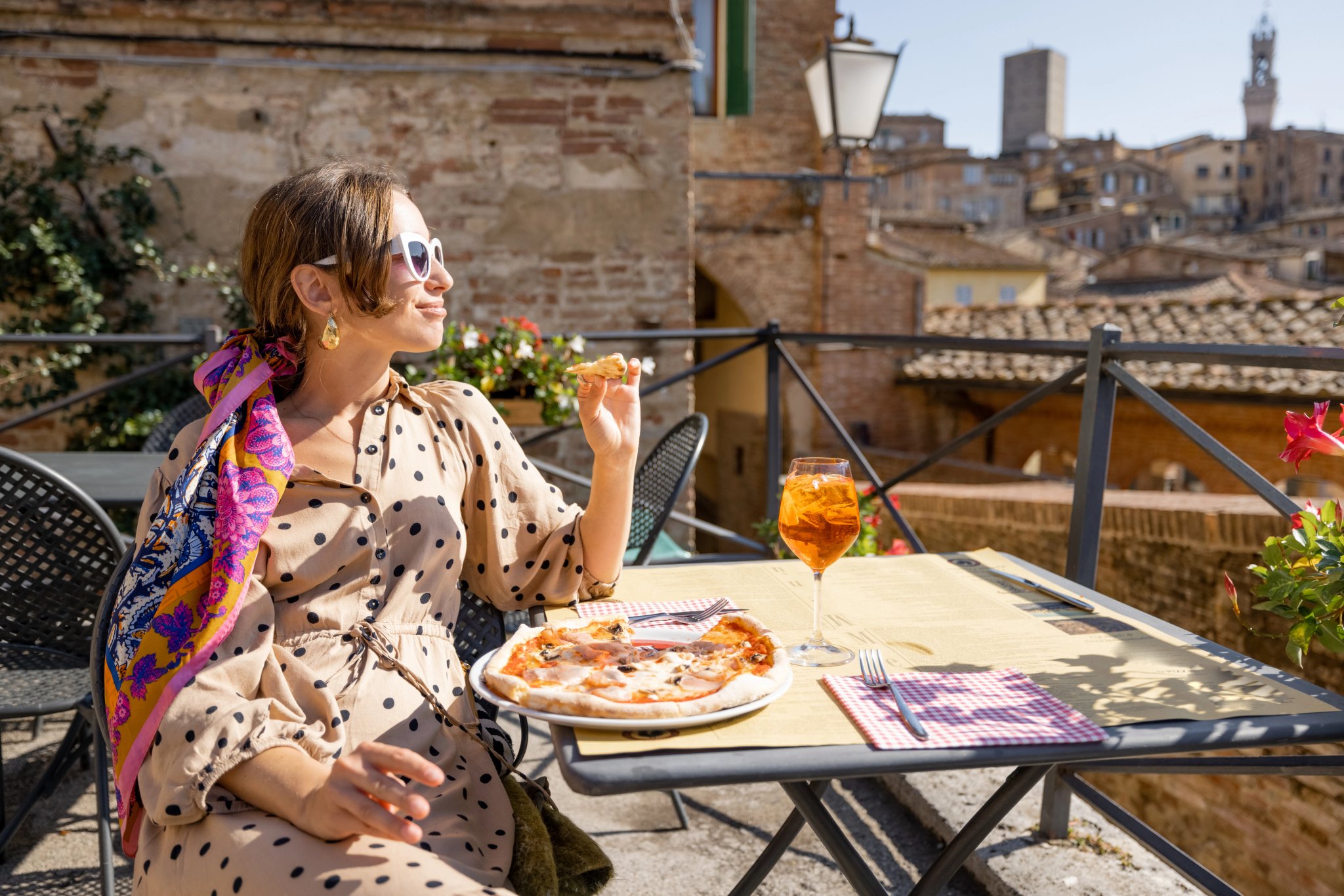
5. Strong cycling infrastructure
The region has thousands of kilometres of cycling routes, quiet secondary roads, rental shops, and accommodations used to hosting cyclists. Everything you need is easy to find.
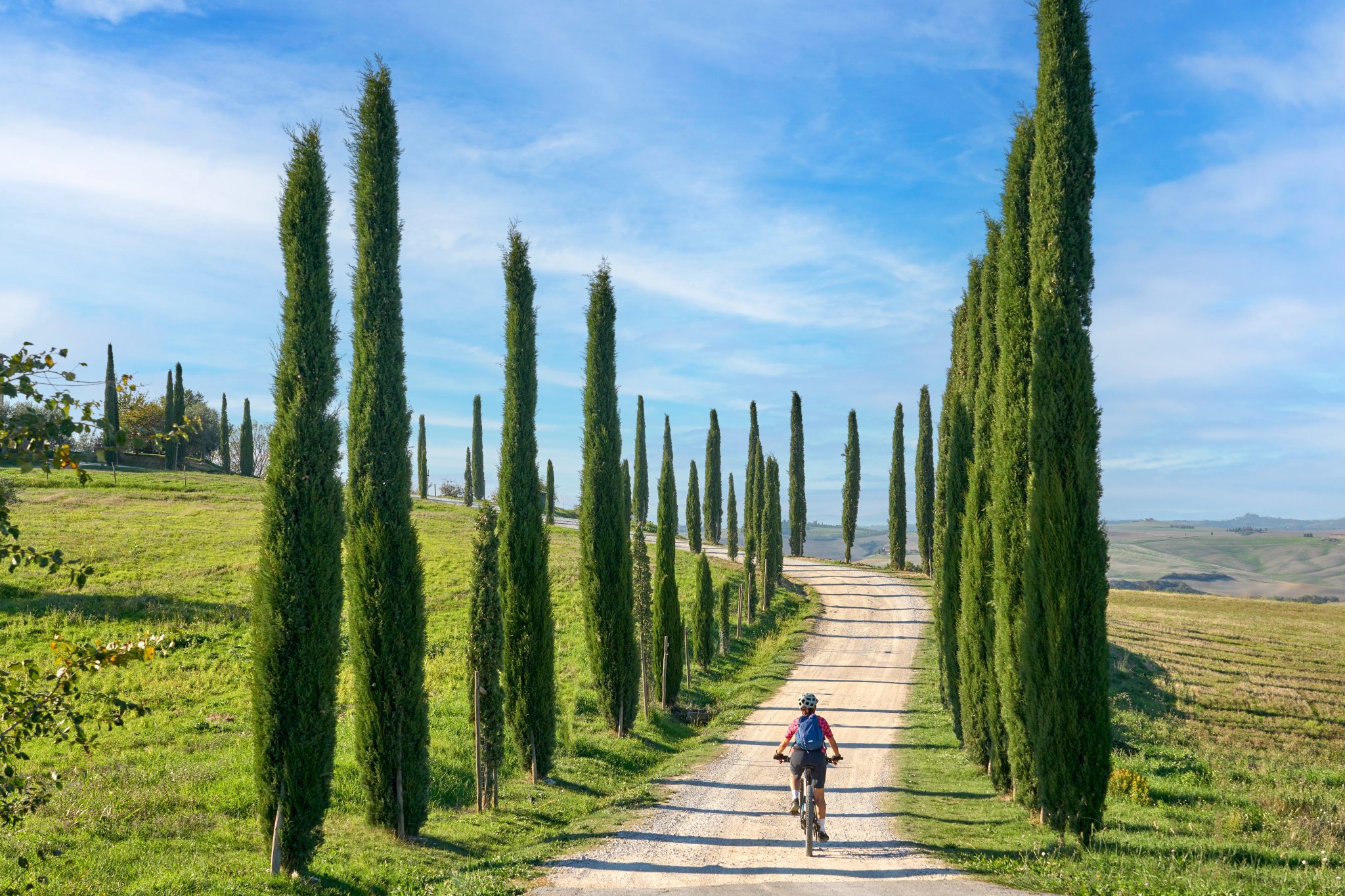
6. Compact, accessible region with huge variety
Tuscany is large enough to offer:
diverse terrains but
compact enough to explore efficiently.
You can ride from vineyard hills to coastal flats or from medieval towns to mountain climbs without long transfers.

7. A long and favourable cycling season
Thanks to its Mediterranean climate and varied elevations, Tuscany offers excellent riding conditions from early spring to late autumn. Lower-altitude and coastal zones remain rideable even in winter.

Quick Overview of Tuscany as a Cycling Destination
Tuscany is one of Europe’s most complete cycling regions — a place where varied landscapes, reliable cycling infrastructure, and genuinely bike-friendly services all come together.
Below is a quick breakdown of what defines Tuscany as a cycling destination.
Location
Tuscany is located in central Italy, stretching from the Tyrrhenian Sea on the west coast to the foothills of the Apennine Mountains in the east. The region covers roughly 23,000 km², making it:
large enough to offer diverse riding conditions but
compact enough that coastal flats, rolling inland hills, and mountain climbs are all within easy reach.
It includes well-known provinces such as Florence, Siena, Pisa, Lucca, Arezzo, and Grosseto. Tuscany’s central position also makes it easy to combine a cycling holiday here with other regions like Umbria, Emilia-Romagna, or Lazio.

Landscapes
Few places offer as much landscape variety as Tuscany. Here’s what you should know at a glance:
Central Tuscany features the iconic rolling hills of Chianti, Val d’Orcia, and Crete Senesi — a mix of vineyards, olive groves, cypress-lined ridges, and medieval hill towns.
Northern Tuscany around Lucca and the Versilia coast is flatter and ideal for faster, easier rides. To the east, the terrain rises into the Apennines, where longer and cooler climbs appeal to riders seeking more elevation.
The Maremma coastline adds something different again: pine forests, coastal plains, gentle seaside roads, and wide-open views. Because the landscapes change quickly across short distances, it’s easy to build a mixed itinerary with different riding styles day to day.
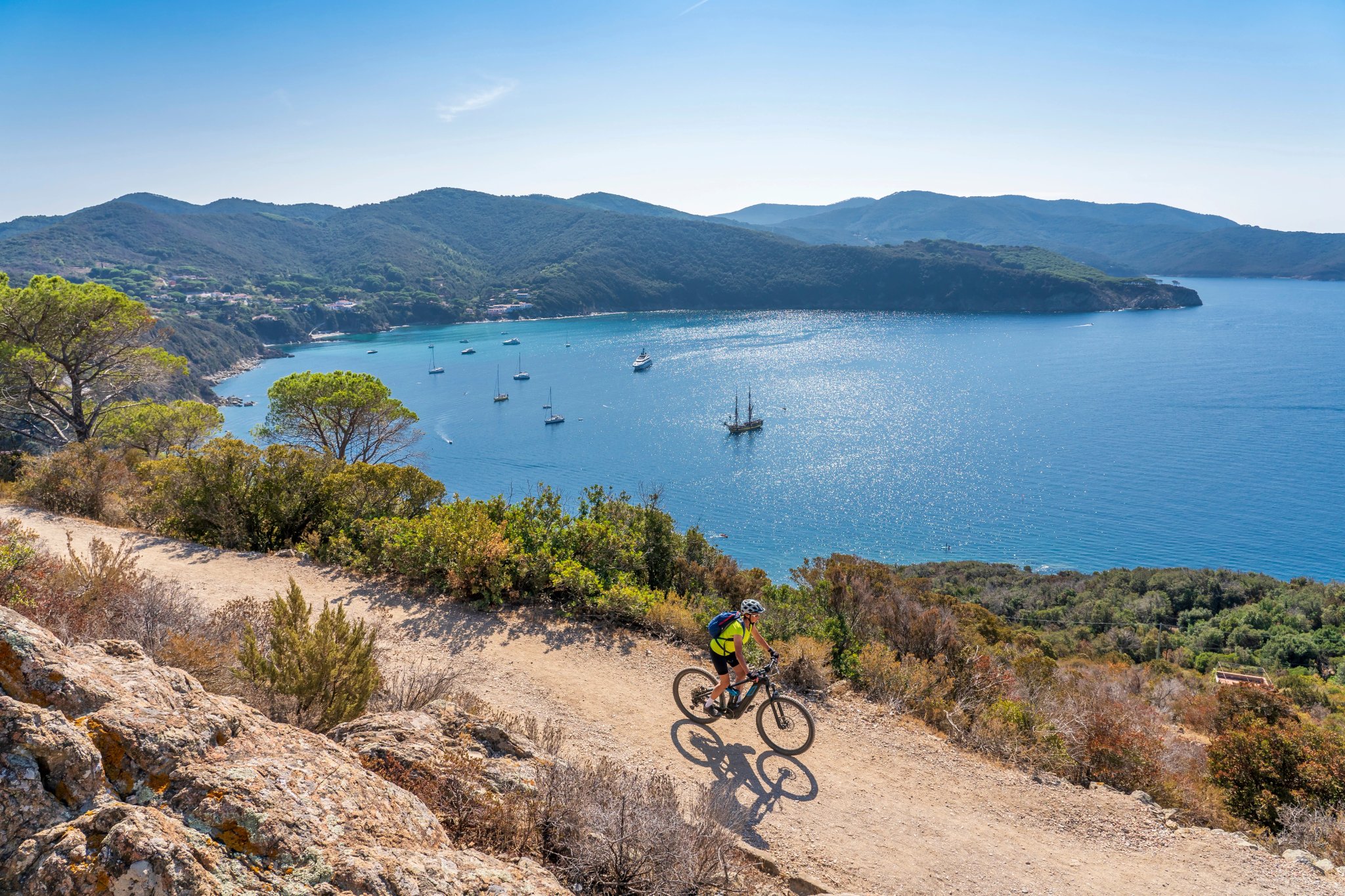
Cycling Infrastructure
Tuscany has developed one of Italy’s best cycling networks, supported by thousands of kilometres of quiet rural roads and mapped cycling itineraries.
The region is famous for its “strade bianche” — white gravel roads that run through farmland, vineyards, and ridges, and feature in major professional races.
Traffic drops noticeably once you leave major cities, and the dense network of secondary roads makes it possible to design loop rides without backtracking. Whether you’re self-guided or on a tour, the infrastructure makes route-planning simple and riding smooth.

Bike-Friendly Services
Cycling tourism is well supported across Tuscany, including essential services, such as:
rental shops for road, gravel, and e-bikes;
repair workshops;
luggage-transfer services;
and hotels equipped with bike storage and washing facilities.
Many cafés and restaurants in cycling areas are accustomed to riders stopping mid-route, and most towns offer easy access to water fountains, small grocery stores, and shaded rest points.
Towns like Lucca, Siena, Pienza, and Greve in Chianti in particular have built strong reputations as cycling hubs. Combined, these services make Tuscany not only beautiful to ride, but also easy and comfortable to navigate.

When to Go
Tuscany has one of the most enjoyable and cyclist-friendly climates in Italy. With mild springs, warm but manageable summers, long golden autumns, and rideable low-altitude winters, the region offers excellent cycling conditions for most of the year.
March–June: Prime cycling season with perfect temperatures
July–August: Hotter inland — best for early starts or coastal routes
September–October: Ideal late-season weather with quieter roads
November–February: Mild but variable conditions, best near the coast and lower elevations

Below is an overview of what to expect in each season so you can plan your Tuscany cycling trip with confidence.
Spring (March–May)
Spring is one of the very best times to cycle Tuscany. The landscapes turn lush green, vineyards start to come alive, and the air is crisp and clear — perfect for long days in the saddle. Temperatures rise steadily without the intensity of summer, and the classic rolling hills are at their most scenic. Traffic is still moderate outside major holiday weekends.
Temperatures: 15–24°C
Best for: All cyclists — ideal balance of warmth, daylight, and comfort
Why ride in spring:
Pleasant temperatures for both long climbs and relaxed rides
Longer daylight hours
Vibrant green hills and excellent visibility
Perfect for road, gravel, and e-bike routes across all regions

Summer (June–August)
Summer in Tuscany is beautiful but warm, especially inland around Siena, Chianti, and Val d’Orcia. If you plan to cycle in these months, timing matters: early-morning starts are essential. The coastal areas and northern zones near Lucca stay cooler thanks to sea breezes. Expect more visitors in tourist hotspots and busier roads around beaches.
Temperatures: 28–35°C (hotter inland in July–August)
Best for: Early starters, coastal riders, and shorter scenic loops
Good to know:
Start early to avoid midday heat
Coastal routes offer cooler temperatures
Expect more tourists, especially near Pisa, Lucca, and the beaches
Gravel routes and open ridgelines get very hot mid-day
If your heart is set on cycling in summer but prefer cooler climbs and quieter roads, consider riding in the Alps. The Dolomites or Slovenia just across the border are wonderful this time of the year.

Autumn (September–November)
Autumn is often considered the best season for cycling Tuscany. The heat drops quickly, the light turns golden, and the region enters the harvest period — a fantastic time for wine lovers. September is warm and lively, while October and early November are quieter, ideal for long scenic rides through Chianti, Val d’Orcia, and the Maremma.
Temperatures: 18–28°C in early autumn, cooling to 12–20°C by November
Best for: Warm but comfortable weather, quieter roads, and cultural exploration
Why ride in autumn:
Stable, comfortable temperatures
Clear skies and perfect visibility for ridge rides
Fewer crowds after mid-September
Harvest season: wine tastings, olive oil mills, and local festivals
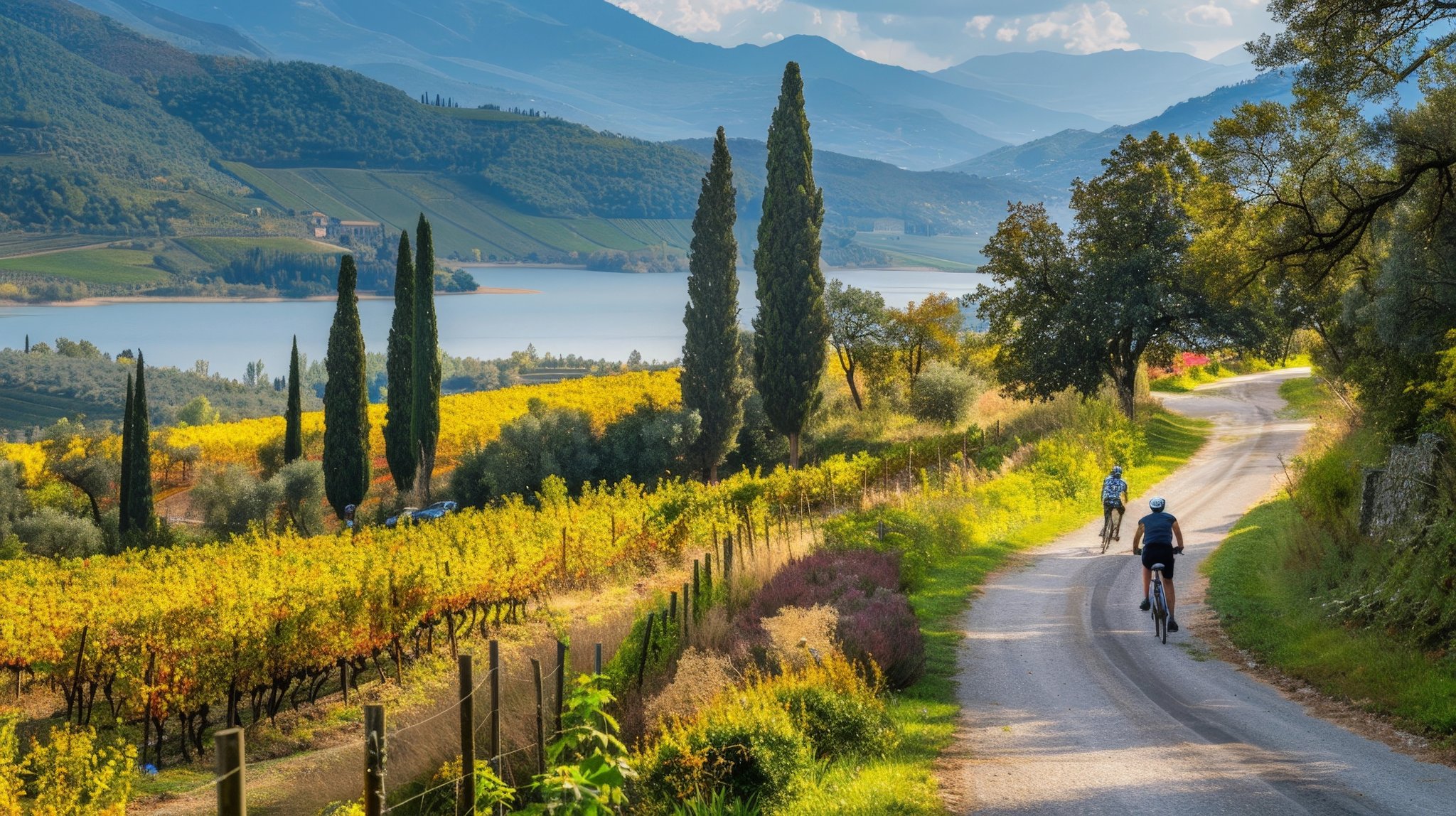
Winter (December–February)
Winter is not ideal for cycling, but Tuscany’s lower elevations and coastal areas remain mild enough for enjoyable riding.
If you are set on cycling during this months, we’ recommend exploring our epic bike tours in Spain and Portugal.

Top Cycling Routes in Tuscany
Tuscany is packed with world-class cycling terrain, but a few regions consistently stand out for their scenery, road quality, and overall riding experience.
From iconic white-gravel sectors to panoramic vineyard loops and breezy coastal roads, these are the areas riders return to again and again.
In a nutshell: the top cycling regions:
Chianti Classico
Strade Bianche & Siena
Val d’Orcia & Crete Senesi
Lucca & the Northern Hills
Maremma & the Tuscan Coast
The Apennines & Casentino

These regions form the backbone of a great cycling trip in Tuscany. Below, we take a closer look at each one — what makes it special, why cyclists love it, and who it’s best suited for.
1. Chianti Classico
(Greve – Panzano – Radda – Gaiole – Castellina)
Best all-around region for classic Tuscan hills, vineyards, and ridge-top views

Chianti Classico is Tuscany’s signature cycling landscape. The area is filled with winding roads through vineyards, olive groves, and medieval wine towns, with steady climbs and long panoramic ridges. Traffic is moderate, and the scenery changes constantly, making it perfect for riders who want the quintessential Tuscany experience without extreme gradients.
Why cyclists love it:
Iconic Tuscan scenery in every direction
Steady, manageable climbs and rewarding descents
Roads connect beautifully → endless loop options
Wine villages perfectly spaced for food and coffee stops
Smooth tarmac + quiet secondary roads
Good for: intermediate riders, road cyclists, e-bikes, scenic explorers
2. Strade Bianche & Siena
(Siena – Asciano – Radi – Castelnuovo Berardenga)
The best region for white gravel and the legendary Strade Bianche sectors

This area forms the core of Tuscany’s famous “strade bianche” network — white gravel lanes used in the Strade Bianche pro race. The mix of rolling hills, ridge passes, and remote farm roads creates some of Europe’s most iconic gravel cycling. Expect beautiful views and a nostalgic, old-world atmosphere.
Why cyclists love it:
Rideable sections of the real Strade Bianche race
Smooth, well-maintained gravel with predictable gradients
Big-sky landscapes and panoramic ridgelines
Perfect balance of challenge and enjoyment
Siena makes an unbeatable start/finish town
Good for: gravel riders, road cyclists comfortable on gravel, strong e-bikers
3. Val d’Orcia & Crete Senesi
(Pienza – Montalcino – Montepulciano – San Quirico d’Orcia)
Best region for postcard landscapes and rolling, cinematic roads
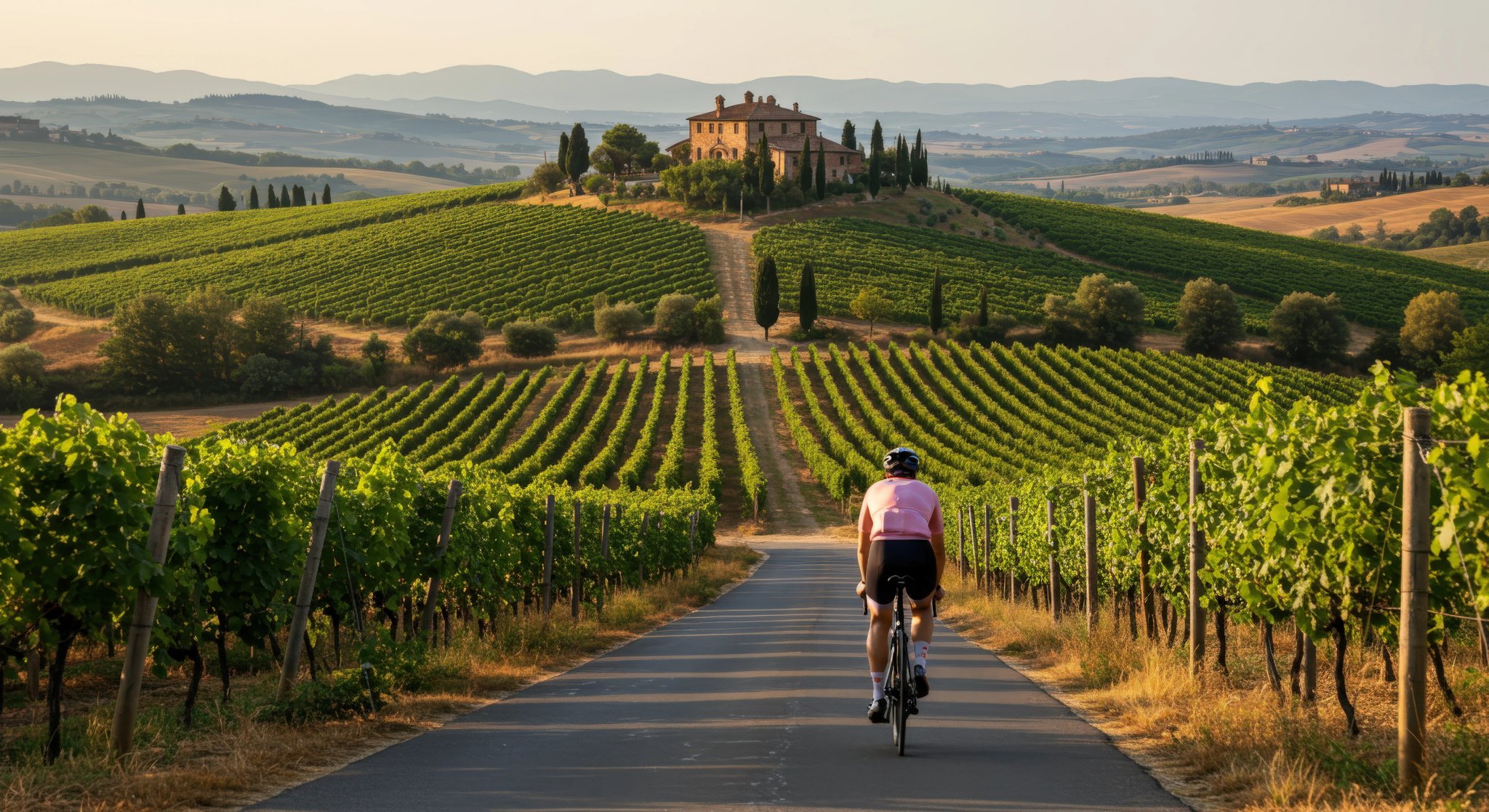
Val d’Orcia is one of Italy’s most photographed regions — and even better on a bike. Long, rolling hills, cypress-lined avenues, and wide-open scenery create a rhythmic ride that feels like cycling through a Renaissance painting. Expect sustained rolling terrain rather than sharp climbs.
Why cyclists love it:
Tuscany’s most iconic viewpoints
Long, scenic ridges perfect for photography
Ideal terrain for steady effort rides
Excellent wine towns for mid-ride stops (Brunello, Vino Nobile)
Both road and gravel routes work beautifully here
Good for: intermediate riders, photographers, gravel fans, scenic road riders
4. Lucca & the Northern Hills
(Lucca – Monte Serra – Garfagnana – Versilia Coast)
Best region for flatter miles, smooth climbs, and summer-friendly riding

Lucca is Tuscany’s most cyclist-friendly base for those who want variety with lower difficulty. The plains around Lucca are flat and fast — a rarity in Tuscany — while the nearby hills offer longer, cooler climbs like Monte Serra. The Versilia coast adds laid-back seaside cycling.
Why cyclists love it:
Plenty of flat or undulating routes
Monte Serra = one of Tuscany’s best long climbs
Cooler temperatures in summer
Strong cycling culture + many rental shops
Easy access to the coast
Good for: beginners, endurance riders, summer travellers, mixed-ability groups
5. Maremma & the Tuscan Coast
(Castagneto Carducci – Bolgheri – Populonia – Marina di Alberese)
Best region for summer cycling and quiet, scenic coastal roads
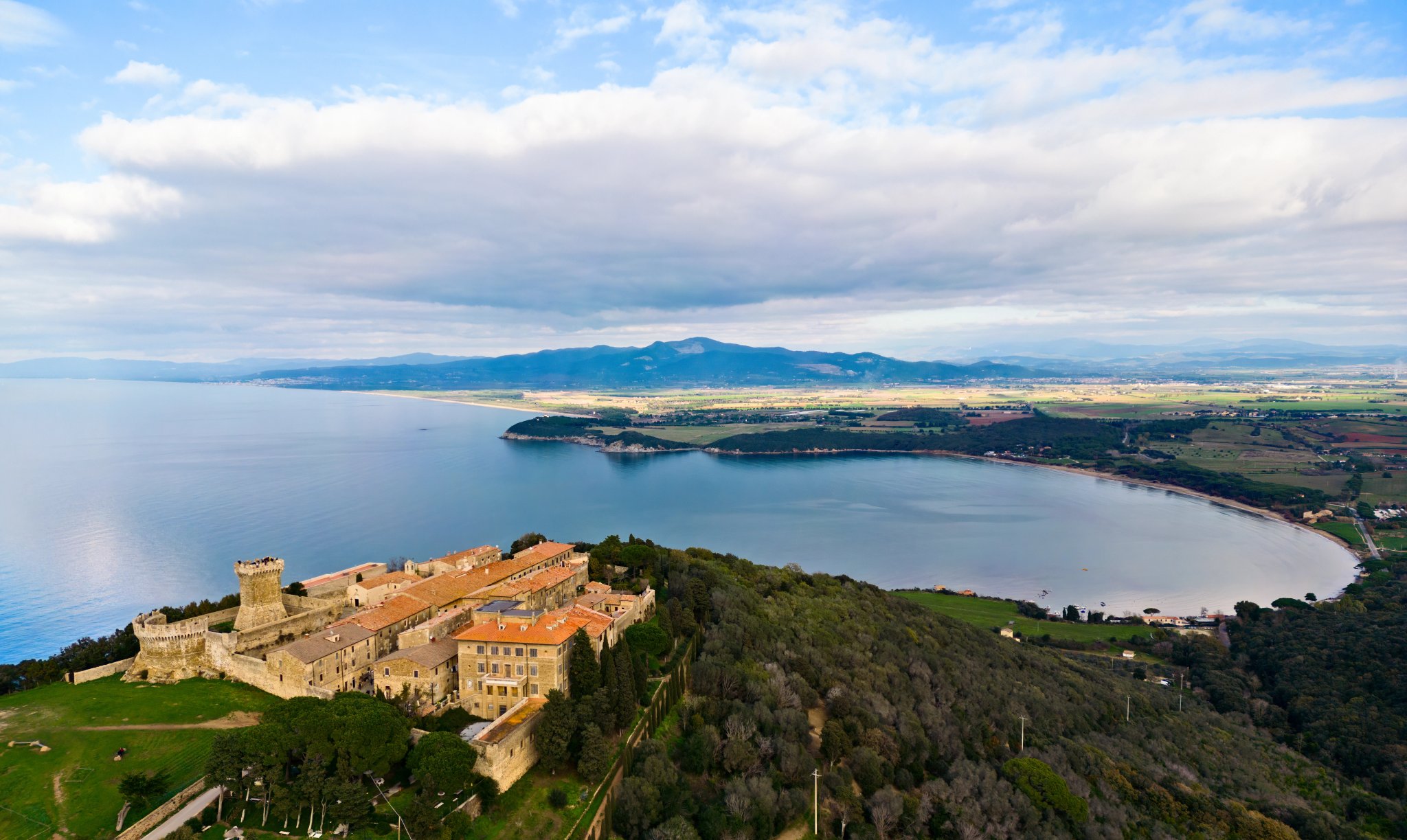
The Maremma coastline is perfect for cyclists wanting sea breezes, pine forests, gentle gradients, and quieter roads than the inland hotspots. The area around Bolgheri offers rolling wine-country terrain, while the southern Maremma opens up into wild coastal landscapes and national parks.
Why cyclists love it:
Cooler temperatures in summer
Flat to rolling coastal roads
Pine forests and seaside promenades
Fewer crowds than inland Tuscany
Excellent food and wine (Bolgheri Superiore region)
Good for: summer riders, casual cyclists, e-bikes, relaxed touring
(PHOTO)
6. The Apennines & Casentino
(Arezzo – Camaldoli – Passo della Calla – Pratomagno)
Best region for challenging climbs and cooler mountain air
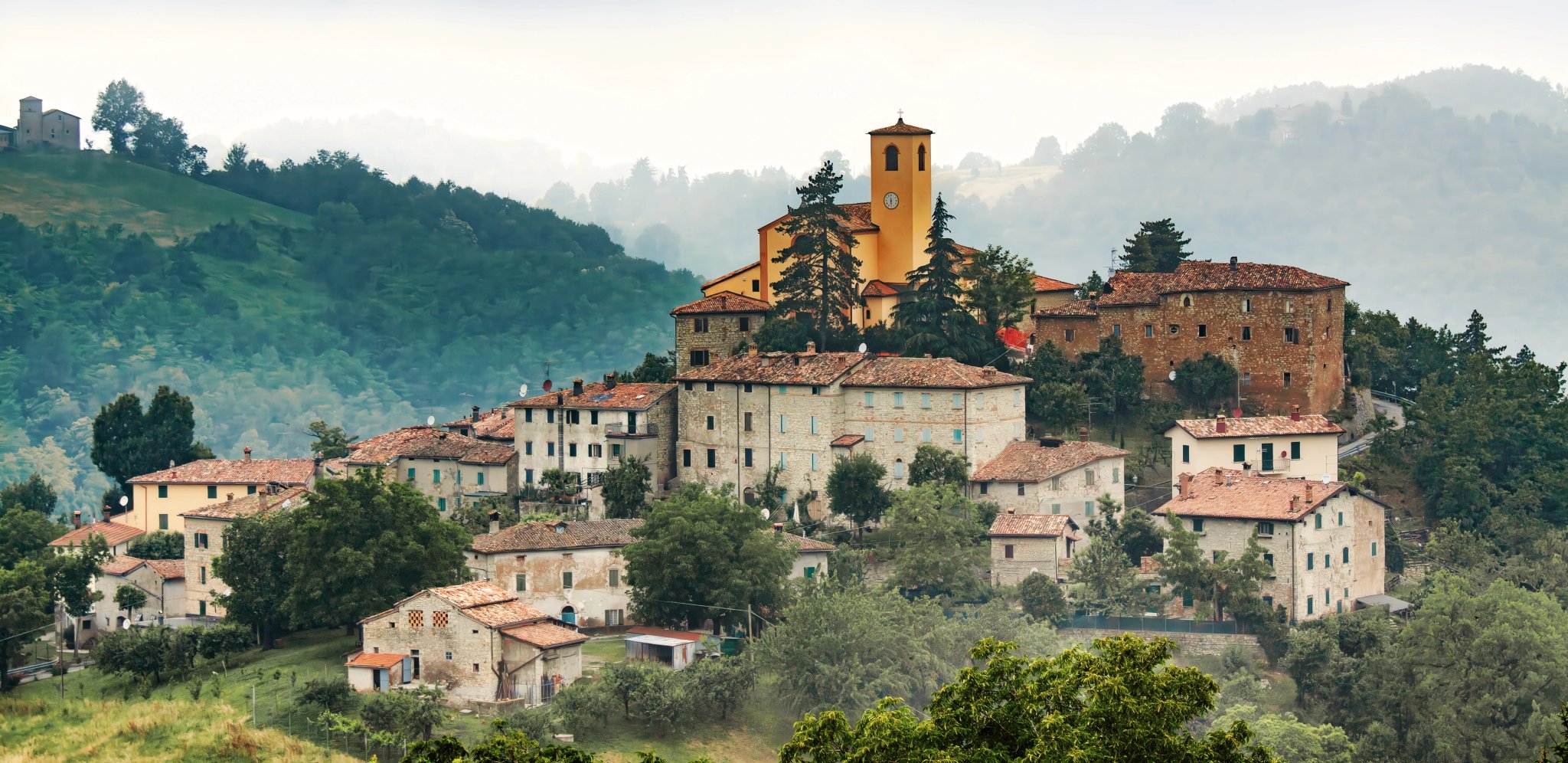
For strong riders, the Apennine foothills and Casentino forests offer long climbs, shady roads, and crisp temperatures — a welcome change from Tuscany’s hot valleys. Expect big elevation gains, forested routes, and rugged landscapes.
Why cyclists love it:
Long, steady mountain climbs
Cooler temperatures in warm months
Low-traffic roads in natural parks
Perfect for big training days
Spectacular descents into Casentino and Arno Valley
Good for: advanced cyclists, climbers, gravel adventurers
Best Base Towns in Tuscany
Choosing the right base can make or break your cycling experience. Tuscany has many beautiful towns, but some work far better for cyclists thanks to terrain variety, road access, bike services, and overall convenience.
Here are the best places to use as your home base — depending on the kind of rides you want.
Lucca
Lucca is one of Tuscany’s top cycling hubs. The terrain around the town is surprisingly flat for Tuscany, making it perfect for warm-up days, recovery rides, and long, fast loops. You also have quick access to hillier terrain north toward the Apennines. The town itself is lively, walkable, and full of cafés — ideal for post-ride evenings.
Why base here:
Excellent mix of flat and hilly rides
Strong bike culture + many rental and repair shops
Close to Pisa Airport
Beautiful walled old town for rest days
Best for: Riders who want variety, easier routes, and convenience.

Siena
Siena sits at the heart of classic Tuscan cycling. The famous Strade Bianche gravel roads extend right from town, and you’re surrounded by rolling hills in every direction. It’s a stunning, medieval city with great food, but expect more climbing than in northern Tuscany.
Why base here:
Perfect access to Strade Bianche
Endless rolling hills and vineyard loops
Close to Chianti + Val d’Orcia
Iconic historic centre
Best for: Gravel lovers, road cyclists who enjoy climbing, and anyone wanting the “classic Tuscany” experience.

Greve in Chianti
Greve sits in the centre of Chianti Classico wine country — a dream setting for scenic, quieter rides. Roads wind through vineyards, olive groves, and panoramic ridges, with climbs that are challenging but steady. Smaller and calmer than Siena, perfect for a countryside-based trip.
Why base here:
Chianti’s best climbing and ridge views
Quieter countryside roads
Easy loops to Panzano, Radda, Gaiole, Castellina
Wine-focused region with great food
Best for: Riders wanting peaceful, scenic routes and a village atmosphere.

Pienza
Pienza is the perfect base for exploring Val d’Orcia — one of the most photographed landscapes in Italy. Expect rolling terrain, cypress-lined hills, and iconic Tuscan views around every corner. It’s gravel heaven and one of the best places for intermediate and advanced riders.
Why base here:
Direct access to Val d’Orcia’s classic roads
Beautiful loops to Montalcino, Montepulciano, San Quirico
Great for both road and gravel
UNESCO landscapes
Best for: Scenic riders, photographers, and anyone wanting the pure “Tuscany countryside” feel.

Montalcino
A paradise for experienced cyclists. Montalcino sits high on a hill, so every ride starts or ends with a climb. The surrounding area mixes smooth tarmac with top-tier gravel routes — including stretches of the Eroica and Strade Bianche corridors. After your ride: Brunello wine.
Why base here:
Challenging climbing routes
Excellent gravel and mixed-terrain options
Authentic medieval atmosphere
Brunello wine culture
Best for: Strong riders and gravel enthusiasts.
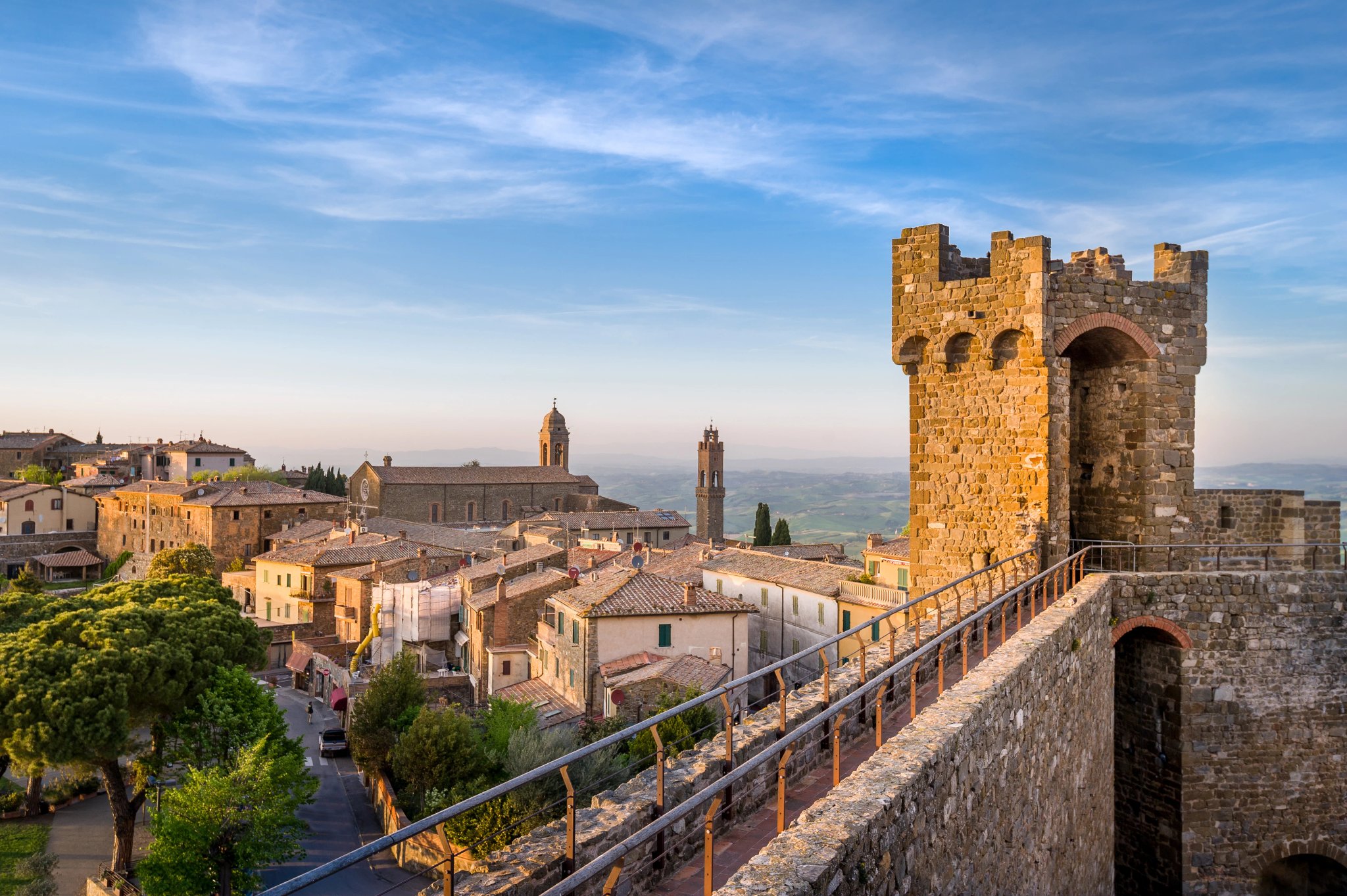
Volterra
Volterra is a great base if you want quieter, less-discovered cycling. The town sits on a steep hilltop, offering instant views and spectacular descents. The rides here are remote, scenic, and perfect for cyclists wanting something beyond the Chianti-Val d’Orcia triangle.
Why base here:
Remote, peaceful cycling
Long ridge roads and valley loops
Dramatic landscapes with fewer tourists
Authentic Tuscan town with Etruscan history
Best for: Riders seeking quieter routes and cinematic landscapes.

The Best Way to Experience Tuscany? Cycle from Village to Village
These towns make fantastic bases — each with its own charm, scenery, and cycling routes. But the truth is, the absolute best way to experience Tuscany is by riding from village to village.
Moving through the landscape day by day lets you soak in everything that makes Tuscany magical and see new places every day.
Many cyclists worry this kind of trip is complicated — “What about the luggage?” “What if we get lost?” “Is it too much to plan?”
Good news: it’s not complicated at all.
With our cycling tours in Tuscany, you'll have everything sorted out, including luggage transfers, detailed gps routes, bike-friendly acommodation etc. No logistics for you, just pure joy on the bike. We are here for you, just say the word.
Must-See Places in Tuscany
Tuscany packs an incredible amount of history and scenery into a small area: medieval cities, UNESCO-listed landscapes, fortified hill towns, hot springs, and world-famous wine regions — all connected by quiet cycling roads.
These are the places that define the region’s character and are easy to visit on or off the bike.

Val d’Orcia
A UNESCO World Heritage landscape, Val d’Orcia embodies the quintessential image of Tuscany — soft rolling hills, cypress-lined lanes, and medieval towns perched above golden fields. The valley, shaped by centuries of harmonious farming, has inspired painters since the Renaissance. Today, it remains one of Italy’s most photographed regions, where light, color, and human craftsmanship merge into a scene of perfect balance.
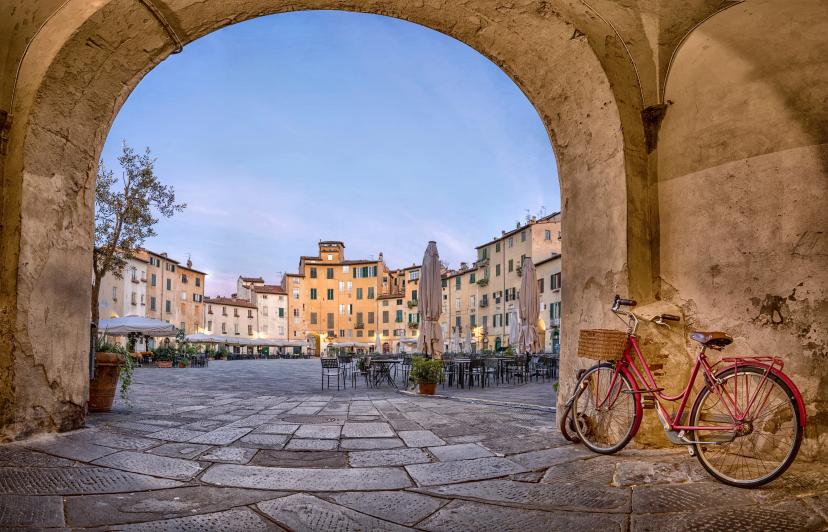
Lucca
Encircled by perfectly preserved Renaissance walls, Lucca is one of Tuscany’s most graceful cities. Its cobbled streets reveal a mosaic of Roman origins, medieval towers, and elegant piazzas. The oval-shaped Piazza dell’Anfiteatro follows the footprint of an ancient Roman arena, while the city’s cathedral holds priceless art by Nicola Pisano.

Orvieto
Rising atop a sheer cliff of volcanic tuff, Orvieto is a city suspended between heaven and earth. Its origins date back to the Etruscans, and beneath its streets lies a labyrinth of ancient tunnels and wells. The Gothic cathedral, with its dazzling façade of mosaics and sculpture, ranks among Italy’s greatest architectural treasures.

Montalcino
Crowned by a medieval fortress and encircled by vineyards, Montalcino is synonymous with the celebrated Brunello wine. Its cobbled streets and honey-colored stone buildings tell stories of prosperity and pride. From the fortress ramparts, sweeping views extend across olive groves and the rolling Val d’Orcia.

Castle of Brolio
Standing amid vineyards near Gaiole in Chianti, the Castle of Brolio is one of the region’s most storied landmarks. Owned by the Ricasoli family since the 12th century, it played a key role in the unification of Italy — Baron Bettino Ricasoli, known as the “Iron Baron,” was a statesman and the creator of the original Chianti wine formula.

Siena
Siena’s medieval heart beats in the shell-shaped Piazza del Campo, where the famous Palio horse race takes place each summer. Once a rival to Florence, the city flourished in art, architecture, and civic life during the Middle Ages. Its striped cathedral, Gothic town hall, and frescoes by Lorenzetti reveal the depth of its cultural heritage.
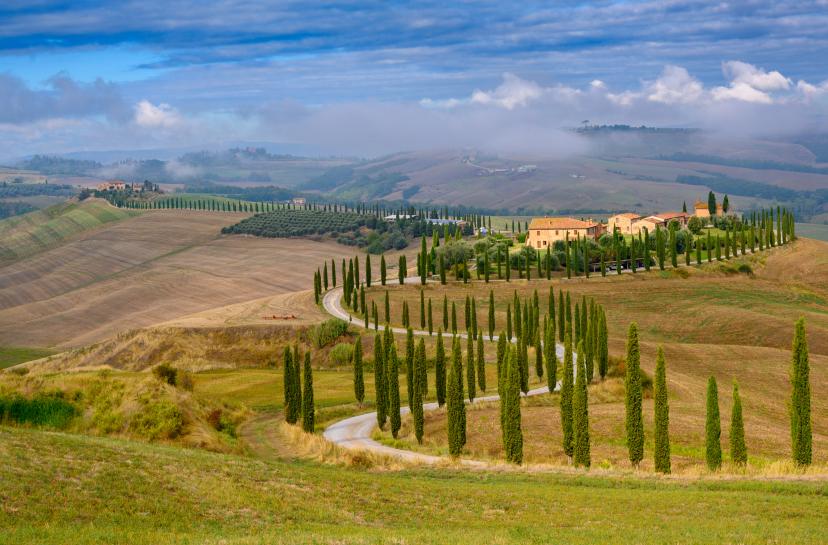
Crete Senesi
South of Siena, the Crete Senesi unfold in a surreal landscape of clay hills, eroded gullies, and silver-gray soil. Often compared to a lunar terrain, this area changes color with the seasons — golden in summer, green in spring, and violet under stormy skies.
How to Get To/From Tuscany
Tuscany is easy to reach from abroad thanks to several international airports both inside and just outside the region. These airports provide the most convenient access for cyclists traveling from the UK, Europe, the US, Canada, Australia, and beyond.
Florence Airport (FLR) – Amerigo Vespucci
Tuscany’s main international airport, located just outside Florence. Small, efficient, and ideal if your cycling trip starts in Florence, Chianti, Siena, or central Tuscany.
Direct flights mainly from major European cities
Quick tram or taxi ride to Florence centre
Easiest gateway to Chianti and the interior hills
Pisa Airport (PSA) – Galileo Galilei
The largest international airport in Tuscany with the best overseas and low-cost connections.
Direct flights from many European cities
On-site train station with fast links to Pisa, Lucca, Florence, and the coast
Best airport for Lucca, Northern Tuscany, and the Tuscan Coast
Bologna Airport (BLQ) – Guglielmo Marconi
Just north of Tuscany, but a major international gateway with many long-haul options.
High-speed trains connect Bologna → Florence in ~35 minutes
Often cheaper and more frequent flights
Great for riders who need global connections or flexible schedules

How to Get Around Tuscany
Tuscany has a reliable public transport network that makes it easy to move between major towns, sightseeing areas, and cycling bases. Below is the cyclist-friendly overview, now including the official transport providers you’ll encounter during your trip.
Trains – Trenitalia (Official Rail Operator)
All regional trains in Tuscany are operated by Trenitalia, Italy’s national rail company.
What cyclists need to know:
Regional trains (R and RV) allow bikes onboard for a small fee.
You must enter the marked bike carriages.
High-speed trains (Frecciarossa, Frecciargento, Italo) do not accept fully assembled bikes unless bagged.
Trenitalia connects all major towns: Florence, Siena, Pisa, Lucca, Arezzo, Grosseto, and coastal areas.

Buses – Autolinee Toscane (Official Regional Bus Network)
All public buses across Tuscany are operated by Autolinee Toscane, which unified the entire region’s bus services. This is the company you’ll use for any inter-town bus journey within Tuscany.
Good to know:
Buses reach areas not served by trains, especially rural zones like Chianti, Val d’Orcia, and village-to-village routes.
Bike transport is not guaranteed — policies vary by vehicle type and driver discretion.
Buses are best used for passengers only, not for moving bikes.
Ideal for: transfers between small towns, getting to accommodation, and moving around when your luggage is being transported separately.

City Transport – ATAF (Florence Urban Transport)
In Florence and its surrounding area, urban buses and city connections are managed by ATAF.
Notes for cyclists:
Good for passenger transfers within Florence
Not suitable for carrying bikes
Useful for getting from hotels to train stations or city landmarks
Driver’s windshield view, Tuscany hills, cypress alleys, steering wheel in foreground, shallow DOF, photorealistic, 4K.

Taxis & Private Transfers
A popular choice for cyclists arriving with bike bags or moving between rural accommodations.
Why use them:
Door-to-door service
Flexible timing
Helpful for reaching smaller villages not served by trains or buses
Common around: Florence, Pisa, Siena, Lucca, and major tourist hubs.

Car Rentals
Useful for arrival and departure days, especially if you’re transporting bike cases.
Pros:
Easy access to rural hotels
Flexible for multi-base trips
Good for groups with luggage
Cons:
Not practical during cycling days
Limited parking in historic towns

Bike-Friendly Tips
Always choose Trenitalia regional trains for bike travel.
Avoid high-speed trains unless your bike is fully packed into a bag.
Check for the bike symbol on train carriages before boarding.
Rural train stations may have limited facilities — bring water.
E-bikes are heavy: ground-level platforms make boarding easier.
Need more practical info on travelling to Italy? Check our ultimate guide on cycling holidays in Italy.
Top Cycling Tours in Tuscany
Tuscany is packed with world-class riding, but these cycling tours hit the sweet spot.
Iconic gravel, rolling wine hills, medieval ridge roads, and big-view climbs — each itinerary showcases a different flavour of cycling Tuscany.
Whether you want fast tarmac, legendary Strade Bianche, or a full “taste it all” adventure, these are the rides that deliver the goods.
Plan Your Tuscany Cycling Adventure
Planning a cycling trip in Tuscany is doable on your own — but with so many routes, hill towns, and rural roads, the logistics can get overwhelming fast. Picking the right bases, finding bike-friendly stays, and organizing transport all take time and local know-how.
That’s where we come in.
We handle:
Bike-friendly accommodation
Digital guidebook + daily route notes
GPS tracks for every stage
Luggage transfers
Local tips, highlights, and hidden gems
Full support before and during your trip
Send us an inquiry and we’ll help you create the perfect cycling holiday in Tuscany.

Hassle-Free
We handle itineraries, accommodations, and anything else you prefer not to deal with, so you can enjoy a carefree holiday.

Completely Customizable
Flexibility is our middle name — whether you want more or less, or just beyond ordinary, we’ll make it happen.

Book with confidence
We are a financially protected company, fully bonded and insured, keeping your money safe and allowing you to travel with confidence.

Unbeatable support
Our 24/7 customer support is where we show our passion, bringing you a better experience by making your well-being our number one priority.


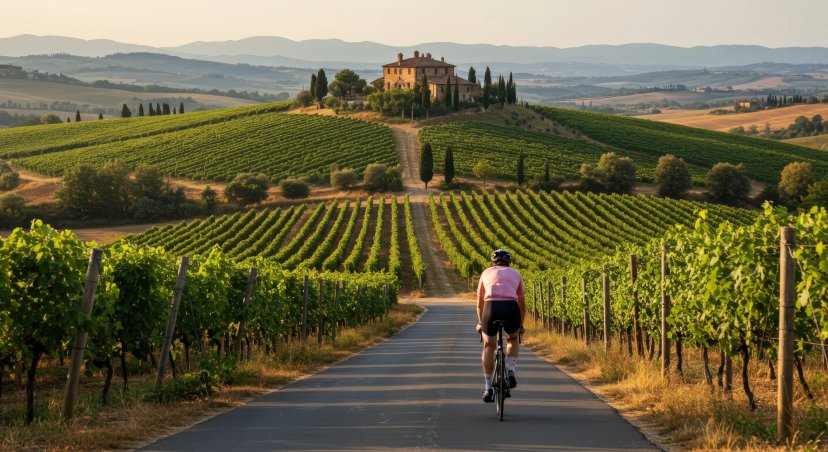

.jpg&w=3840&q=75)
